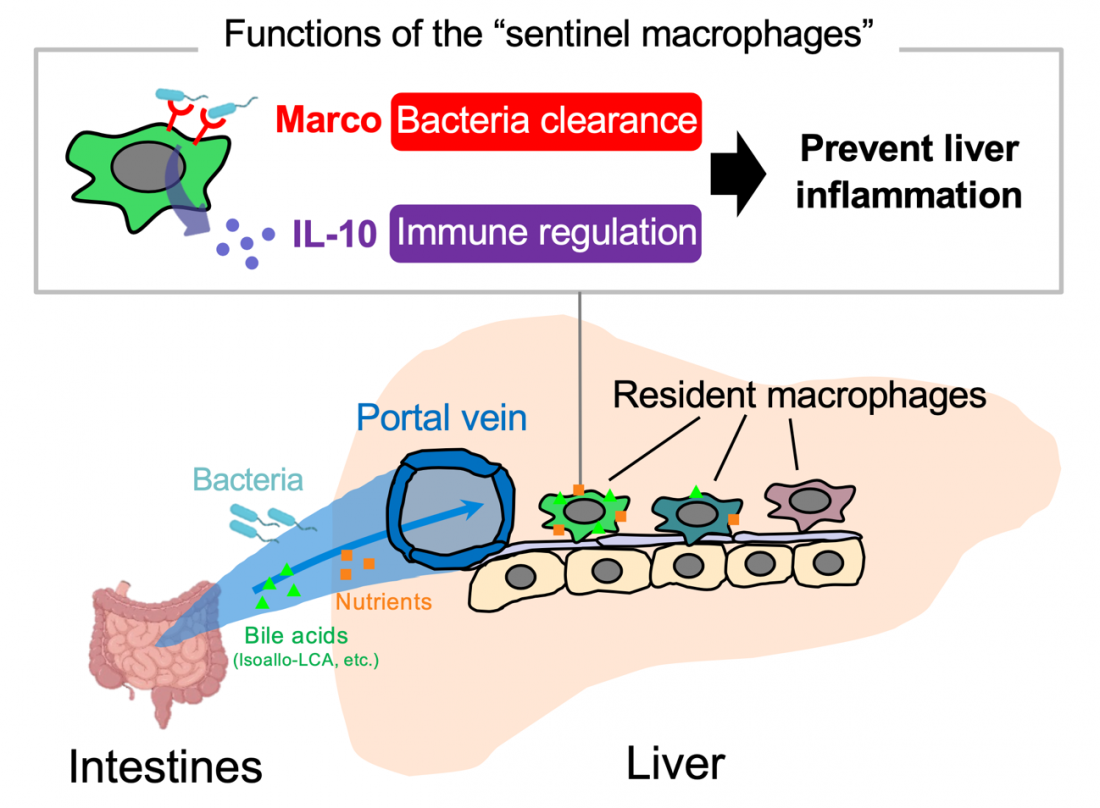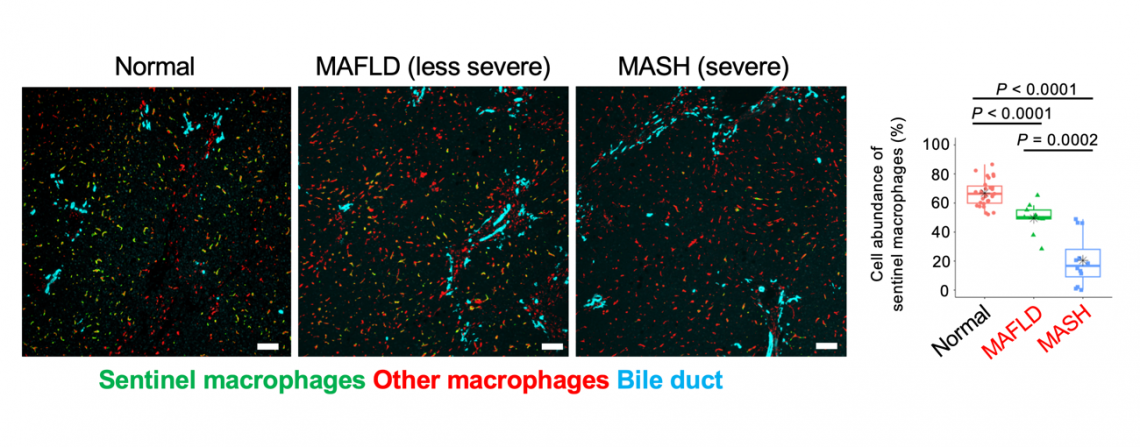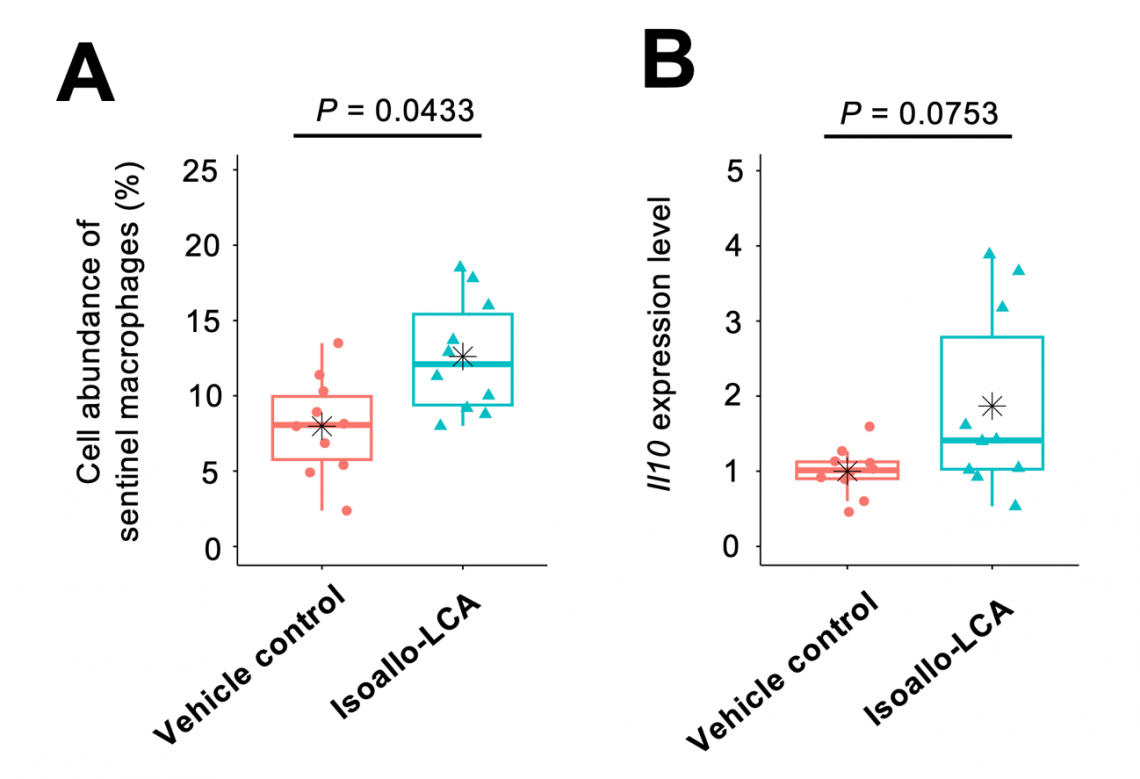"Sentinel macrophages" at the gateway of the liver phagocytose the gut-derived pathogens and produce the anti-inflammatory proteins, thereby suppressing surrounding inflammatory responses.
Osaka, Japan - The liver and intestines are directly connected via the portal vein, a blood vessel that transports nutrients absorbed in the intestines directly to the liver. The intestines harbor numerous gut bacteria, and sometimes these bacteria and their related substances can enter the liver through the portal vein. This is especially problematic when the intestinal barrier is compromised, as seen in conditions like ulcerative colitis or leaky gut syndrome, allowing many gut bacteria and related substances to reach the liver. Under normal circumstances, the liver’s immune system is able to defend against the invading gut bacteria and related substances and prevent inflammation, but the exact mechanism behind this was unclear.
Abundance of the “liver sentinel macrophages” in normal and disease human livers. The livers from metabolic dysfunction-associated fatty liver disease (MAFLD, less severe) and steatohepatitis (MASH, severe) were shown as the disease livers. Green: Sentinel macrophages, Red: Other normal macrophages, Cyan: Bile duct. Scale bar: 100 µm. Quantitative data are presented as the means (asterisk) with medians, smallest observations, lower and upper quartiles, and largest observations.
Using innovative technologies like in vivo imaging of the liver and analysis of single-cell gene expression while preserving tissue locational information, a research group led by Yu Miyamoto and Masaru Ishii at the Graduate School of Medicine of Osaka University has revealed that certain resident macrophages near the entrance of the liver protect it against intestinal bacteria and related substances. Their findings are illustrated in Figure 1. Dr. Miyamoto, a lead author of the study, explained, “Our technology showed that these ‘sentinel macrophages’ play a crucial role in protecting the liver from inflammation caused by intestinal bacteria and related substances." Additionally, the study found that isoallo-lithocholic acid (isoallo-LCA), a secondary bile acid produced by some gut bacteria, trigger the activation of these sentinel macrophages.
Induction of the liver sentinel macrophages by isoallo-lithocholic acids (isoallo-LCA). Abundance of “sentinel macrophages” in the liver (A) and expression level of the anti-inflammatory cytokine IL-10 in liver resident macrophages (B) two weeks after daily oral administration of isoallo-LCA or vehicle control. Data are presented as the means (asterisk) with medians, smallest observations, lower and upper quartiles, and largest observations.
With the rise in conditions like leaky gut due to modern lifestyles (stress, high-fat diets, and lack of exercise), there is increasing concern about inflammation affecting various organs, including the liver. Metabolic dysfunction-associated steatohepatitis (MASH), often accompanied by the leaky gut, has been particularly concerning due to its ever increasing incidence and challenging treatment. This research shed light on how liver sentinel macrophages defend against gut commensal invaders, offering hope that enhancing their functions could lead to the development of new preventive and therapeutic strategies for liver chronic inflammatory diseases, including MASH.
###
The article, “Periportal macrophages protect against commensal-driven liver inflammation” was published in Nature at DOI: https://www.nature.com/articles/s41586-024-07372-6
About Osaka University
Osaka University was founded in 1931 as one of the seven imperial universities of Japan and is now one of Japan's leading comprehensive universities with a broad disciplinary spectrum. This strength is coupled with a singular drive for innovation that extends throughout the scientific process, from fundamental research to the creation of applied technology with positive economic impacts. Its commitment to innovation has been recognized in Japan and around the world, being named Japan's most innovative university in 2015 (Reuters 2015 Top 100) and one of the most innovative institutions in the world in 2017 (Innovative Universities and the Nature Index Innovation 2017). Now, Osaka University is leveraging its role as a Designated National University Corporation selected by the Ministry of Education, Culture, Sports, Science and Technology to contribute to innovation for human welfare, sustainable development of society, and social transformation.
Website: https://resou.osaka-u.ac.jp/en





